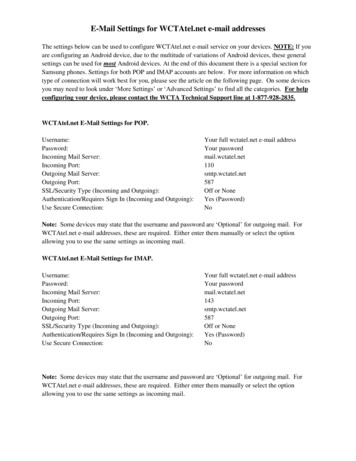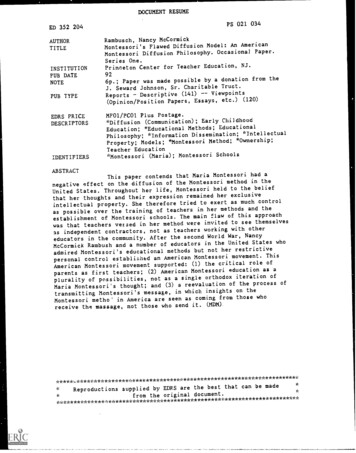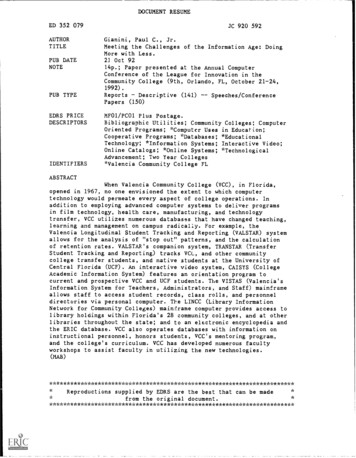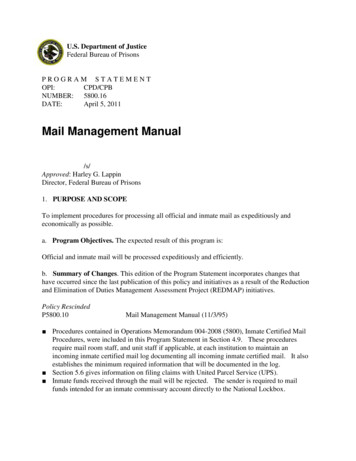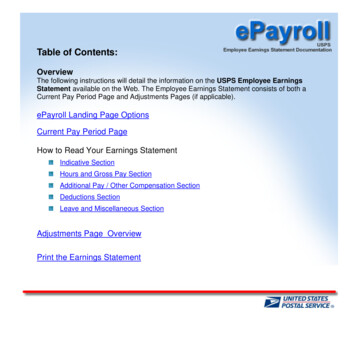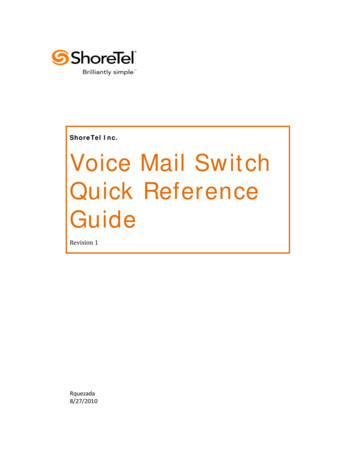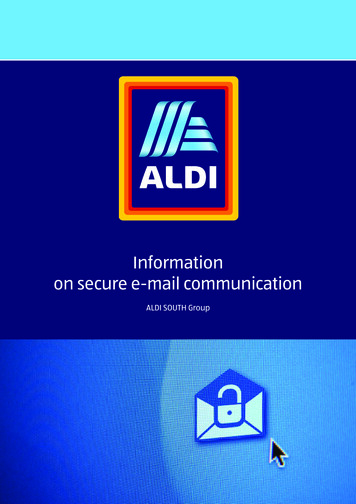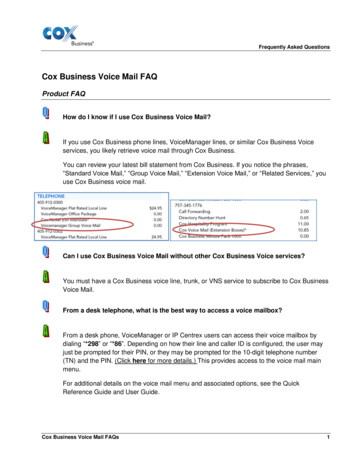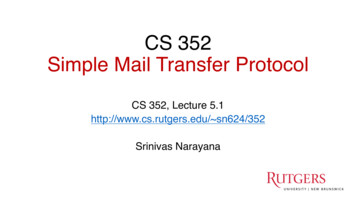
Transcription
CS 352Simple Mail Transfer ProtocolCS 352, Lecture 5.1http://www.cs.rutgers.edu/ sn624/352Srinivas Narayana1
We’re all familiar with email.How does it work?
outgoingmessage queueElectronic Mailuser mailboxuseragentThree major components:1. User agents a.k.a. “mail reader”mailserveruseragentSMTPe.g., Applemail, OutlookSMTP Web-based user agents (ex: eragentuseragent3
Electronic Mail: Mail servers2. Mail Servers Mailbox contains incoming messagesfor user Message queue of outgoing (to be sent)mail messages Sender mail server makes connectionto Receiver mail server IP address, port 253. SMTP protocol Used to send messages Client: sending user agent or sendingmail server server: receiving mail nt4
Scenario: Alice sends message to Bob4) SMTP client sends Alice’smessage over the TCPconnection5) Bob’s mail server places themessage in Bob’s incomingmailbox1) Alice(alice@rutgers.edu) usesUA to compose message tobob@nyu.edu2) Alice’s UA sends message toher mail server; messageplaced in outgoing messagequeue3) Client side of SMTP opensTCP connection with Bob’smail server1Aliceuseragent2mailserver3Rutgers mail server6) Sometime later, Bob invokeshis user agent to readmessagemailserver456NYU mail serveruseragentBob5
Observations on these exchanges Mail servers are useful “always on” endpoints Receiving the email on behalf of Bob, should Bob’s machine be turned off Retrying the delivery of the email to Bob on behalf of Alice, should Bob’smail server be unavailable in the first attempt The same machine can act as client and server based on context Rutgers’s mail server is the server when Alice sends the mail It is the client when it sends mail to Bob’s mail server SMTP is push-heavy: info is pushed from client to server Contrast to HTTP or DNS where info is pulled from the server
Sample SMTP interaction A small demo
Sample SMTP interaction220 hill.com SMTP service readyHELO town.com250 hill.com Hello town.com, pleased to meet youMAIL FROM: jack@town.com 250 jack@town.com Sender okRCPT TO: jill@hill.com 250 jill@hill.com Recipient okDATA354 Enter mail, end with “.” on a line by itselfJill, I’m not feeling up to hiking today. Will you please fetch me a pail of water?.250 message acceptedQUIT221 hill.com closing connection8
MAIL command response codes220: Service ready250: Request command complete354: Start mail input421: Service not available9
Mail message (stored on server) formatSMTP: protocol for exchanging email msgsheaderRFC 822: standard for text message format:blankline header lines, e.g., To: From: Subject:different from SMTP commands!(these would still be under “DATA”)body body the “message”, ASCII characters only10
Message format: multimedia extensions MIME: multimedia mail extension, RFC 2045, 2056 additional lines in msg header declare MIME content typeMIME versionmethod usedto encode datamultimedia datatype, subtype,parameter declarationencoded dataFrom: alice@crepes.frTo: bob@hamburger.eduSubject: Picture of yummy crepe.MIME-Version: 1.0Content-Transfer-Encoding: base64Content-Type: image/jpegbase64 encoded data .base64 encoded data11
CS 352Mail: Access ProtocolsCS 352, Lecture 5.2http://www.cs.rutgers.edu/ sn624/352Srinivas Narayana12
Mail access protocolsSMTPAliceSMTPuseragentsender’s mailserverPOP3 or IMAP4access userprotocol agentBobreceiver’s mailserver SMTP: delivery/storage to receiver’s server Mail access protocol: retrieval from server POP: Post Office Protocol [RFC 1939] Client connects to POP3 server on TCP port 110 IMAP: Internet Mail Access Protocol [RFC 1730] Client connects to TCP port 143 HTTP: gmail, outlook, etc.13
POP vs IMAP POP3 Stateless server UA-heavy processing UA retrieves email fromserver, then typically deletedfrom server Latest changes are at the UA Simple protocol (list, retr, delwithin a POP session) IMAP4 Stateful server UA and server processing Server sees folders, etc.which are visible to UAs Changes visible at the server Complex protocol14
What about web-based email? Connect to mail servers via web browser Ex: gmail, outlook, etc. Browsers speak HTTP Email servers speak SMTP Need a bridge to retrieve email using HTTP15
Web based emailHTTPHTTPHTTP serverHTTPserverSMTPClientSMTPserverInternet16
Comparing SMTP with HTTP HTTP: pull SMTP: push both have ASCII command/response interaction, status codes HTTP: each object encapsulated in its own response msg SMTP: multiple objects sent in multipart msg HTTP: can put non-ASCII data directly in response SMTP: need ASCII-based encoding17
More themes from app-layer protocols Separation of concerns. Examples: Content rendering for users (browser, UA) separate from protocol operations (mailserver) Reliable mail sending and receiving: mail UA doesn’t need to be “always on” tosend or receive email reliably In-band vs. out-of-band control: In-band: headers determine the actions of all the parties of the protocol There are protocols with out-of-band control, e.g., FTP Keep it simple until you really need complexity ASCII-based design; stateless servers. Then introduce:Cookies for HTTP stateIMAP for email organizationSecurity extensions (e.g., TLS)Different methods to set up and use underlying connections (e.g., persistence)18
Comparing SMTP with HTTP HTTP: pull SMTP: push both have ASCII command/response interaction, status codes HTTP: each object encapsulated in its own response msg SMTP: multiple objects sent in multipart msg HTTP: can put non-ASCII data directly in r
